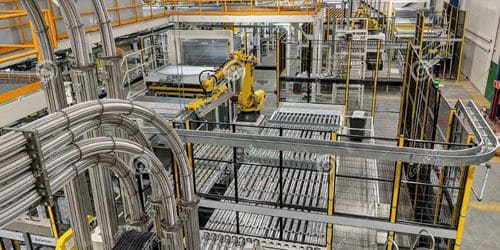The importance of manufacturing to the world economy is beyond dispute. Do you want to find out more about manufacturing plant? Then stay with me as I go through everything you need to know about Toyota, Challenge, Ford, and Sherwin Williams manufacturing plant.
What Is a Manufacturing Plant?
Companies that are just starting out can get a lot out of investing in manufacturing plants. It is a company that either produces its own items or provides services to other businesses. Factories like these tend to pop up in areas with both high demand for the goods they make and low labor costs. In addition, it’s usually a business that needs a lot of money and a lot of time to get off the ground. A manufacturing plant’s output, however, might be quite lucrative. Businesses in the manufacturing sector can rake in hundreds of millions of dollars every year.
History of Manufacturing Plants
When a guy named Thomas Jefferson built a machine that could generate more things than he could produce by hand, this marked the beginning of the birth of the manufacturing industry. He dubbed his creation the “water wheel,” and it enabled him to generate income by reselling the commodities that he had produced in excess. The industrial sector didn’t get its start until much later, but from that point on, individuals began making items for sale.
Around the year 1750 marked the beginning of the Industrial Revolution, which lasted well into the 19th century. This event signified the beginning of the shift from rural livelihoods to an urban economy. Until this time, the majority of people held jobs in the agricultural sector. However, after the discovery of steam power, manufacturing took over as the primary engine of economic growth.
Hence, because of these shifts, a new middle class emerged, which sparked the beginning of the consumer revolution. The current wave was the introduction of automobiles, which resulted in a dramatic increase in the need for fuel, electricity, and oil. These shifts have had a huge influence on the world, and we are still dealing with the fallout from those changes today.
What Is Another Name for a Manufacturing Plant?
Its synonyms are “factory,” “manufactory, and “mill.”
How Do Manufacturing Plants Work?
The presence of manufacturing plants is unavoidable in contemporary society. These establishments house the vast majority of the manufactured products and services.
They can be as simple as those that make common home products or as complex as those that manufacture technological devices. Manufacturing plants function in much the same way as large factories. They produce things in an effective and dependable manner. In this process, a product is made in a controlled environment so that its quality can be kept. It also entails organizing the efforts of a large number of individuals and agencies from different organizations, which makes it a highly skilled position.
Hence, to be a successful manufacturer, you need to have a comprehensive understanding of the whole manufacturing process, from product design and engineering through production and customer service, as well as logistics and supply chain management. Most of the time, the manufacturers hire professional engineers and architects to plan these factories. With the help of blueprints and plans, these people will make the plant’s design and build it. This lets the plant be put together in the most efficient way possible.
Challenge Manufacturing Plant
Challenge manufacturing plant was established in a garage in Walker, Michigan, in 1981. The Challenge manufacturing plant, which began with a single machine 40 years ago, has expanded greatly since then. Challenge’s original Walker, Michigan, headquarters remains intact, but the company has expanded to twelve more sites in North America and Asia. The challenge manufacturing plant employs a total of around 3,000 people with the help of 1,500 industrial robots.
In addition, Challenge manufacturing plant takes great satisfaction in being true to its founding principles, corporate culture, and competitive edge within its dynamic market.
Why Is Challenge Different From Other Games?
Employees own a majority stake in Challenge manufacturing plant. Their staff members are able to partake in the organization’s growth thanks to the Employee Stock Ownership Plan (ESOP). The ESOP also helps the business foster an environment where employees are encouraged to pitch in and work together. As of 2017, the Challenge manufacturing plant was the 40th largest ESOP company in the United States.
Toyota Manufacturing Plant
On August 28, 1937, Kiichiro Toyoda founded the Toyota Manufacturing Plant, which was recognized the following year. Toyota, one of the nation’s largest manufacturing plant, produces about 10 million cars a year. Kiichiro’s father, Sakichi Toyoda, established Toyota Manufacturing, a machine manufacturer, and the new company grew out of that. One of the nation’s biggest corporations, Toyota Group, has acquired both firms. Type A engines were produced in 1934 while the firm was still a division of Toyota Industries, and the Toyota AA was introduced as a passenger automobile the following year, in 1936.
After WWII, Toyota manufacturing plant took advantage of Japan’s partnership with the US to study American car manufacturers and other businesses. This led to the development of The Toyota Way and the Toyota Manufacturing System, which propelled the once-modest company to the forefront of its field and made it the focus of numerous academic investigations.
Its Purpose
The Toyota manufacturing plant capitalized on the rising middle class in Japan in the 1960s to fuel production at the plant. It ended up being the best-selling car in history. As of December 2020, thanks in large part to the expanding global economy, the Toyota manufacturing plant will be the largest firm in Japan and the fifth or sixth company in the world in terms of revenue, making it one of the world’s largest automakers. In 2012, Toyota announced that it had produced its 200 millionth vehicle, making it the first automaker in the world to achieve an annual output of more than 10 million automobiles.
Toyota has led the hybrid electric car market since the 1997 launch of the Prius due to its fuel efficiency. More than 40 different hybrid car models are now being sold by the company. Recently, Toyota has indeed been charged with misleading consumers due to its skepticism of fully electric vehicles and its preference for developing hydrogen fuel cell vehicles like the Toyota Mirai, which use more expensive systems that have lagged well behind battery packs. Nevertheless, in late 2022, the company secured a £11.3 million official deal with the UK’s Department of Business, Energy, and Industrial Strategy to aid in the development of its Hilux FC model, a new line of hydrogen-powered pickup trucks.
You may want to see: TOYOTA FINANCIAL: Toyota Reviews 2023
Ford Manufacturing Plant
The Ford manufacturing is an American automobile manufacturing conglomerate with headquarters in the city of Detroit, Michigan. The Ford manufacturing plant is in the business of creating, selling, and maintaining Ford automobiles, trucks, SUVs, and luxury automobiles. When it comes to the production of automobiles, Ford is right up there with the best of them. The business is divided into the Auto Parts, Finance, and Insurance, Ford Smart Mobility LLC, and Central Treasury Operations divisions. Their auto division is also the second largest in the country.
Ford Manufacturing Plant Count by Location
Automobiles, service parts, and equipment sold under the Ford name are essentially what the company’s auto division focuses on selling around the world. This is along with the costs involved in designing, creating, distributing, and servicing these products. Further service agreements are available from the firm. Ford Focus, Ford Fusion, Ford Flex, Ford Fiesta, Lincoln Tempest, etc. are only a few of the well-known automobiles produced by Ford. Main rivals include GM, Honda, PSA, VW, and others.
The corporation is structured into North American, South American, Asia-Pacific, European, Middle Eastern, and African regional business units. Considering its origins in the United States, it makes sense that its factories would be concentrated there. Although Ford still operates roughly as many plants as it did in 2010, the company has been gradually cutting back on its global footprint. By the end of 2014, the number of factories around the world had dropped to 62. In 2015, this figure rose to 67 from 64 the year before.
Likewise, in 2015, the Asia-Pacific area had twelve factories; by 2016, only seven remained, and by 2017, only four left. Europe has 16 manufacturing plants in 2015, up from 12 the year before. Since 2010, the number had been falling. There was no change in the number of units until 2018, when one manufacturing plant was closed. There was no rise or decrease in the number of manufacturing plants in the Middle East and Africa between 2015 and 2018; the total remained at 2. The overall number of plants in South America remained stable in 2010.
For some years, Ford’s performance in the Asia-Pacific region has been terrible. Ford intends to grow manufacturing in the Asia-Pacific region as part of its expansion plans.
Sherwin Williams Manufacturing Plant
The dedicated global supply chain team at Sherwin-Williams manufacturing plant makes use of state-of-the-art infrastructure to provide world-class support to their clients in every market we serve. Their 137 manufacturing and shipping facilities are spread over five continents. However, their 15 thousand strong team works together as one unified unit.
Development, production, manufacturing, packaging, and shipping are all part of their comprehensive supply chain. Sherwin-Williams manufacturing plant is committed to reducing complexity and increasing value throughout the supply chain through coordinated efforts with our sales teams.
Review process, process improvement, rapid root cause analysis, and timekeeping are the pillars of Sherwin-Williams manufacturing plant. Their management system serves as the road map for how we put our people, infrastructure, and procedures to use. The culture of continual improvement it fosters is the bedrock upon which we build our record of success across all of our business endeavors around the world.
Their services
As is our worldwide bidding process, which is built on a foundation of continual development. Hence, with long-term cost savings and a variety of raw resources, the supply chain team consistently improves supply reliability year after year.
In addition, a strong pipeline can be maintained by providing solutions that are informed by client input and feedback. Sherwin-Williams is preparing itself for the future of work by investing in cutting-edge robotics and technology trends. This will be done within its current footprint and with cooperation among workers.
Our state-of-the-art strategy for the supply chain puts us in a prime position to provide the best possible service to our customers, both now and in the future.
What Is A Good Manufacturing Efficiency?
When it comes to measuring the success of a company’s quality management system, good manufacturing efficiency (GME) is a key indicator. Growth in market share (GME) is an indicator of how well a firm is doing in terms of product quality. GME measures how efficient a manufacturing process is relative to its inputs.
A huge number of products can be produced quickly by a company with high operational efficiencies. Such productiveness is typical of factories employing production techniques.
What Is an Example of a Manufacturing Plant?
They include:
- Furniture factories
- Clothing factories.
- Textile plants.
- Automotive plants.
What Do You Do at a Manufacturing Plant?
Production lines or specially designated regions in a factory are common features of manufacturing plants. Products could be mass-produced for distribution to retailers or made on demand to meet specific customer needs.
What Is the Difference Between Manufacturing Plant and Production Plant?
The production of a manufacturer’s finished goods typically involves the use of discernible processes, such as manual labor or machinery. The creation of goods and services by production corporations typically involves the utilization of various pieces of machinery. Nevertheless, these businesses are also able to produce objects through the employment of manual effort.
References
- benjaminwann.com
- en.wikipedia.org
- businessquant.com
- corporate.sherwin-williams.com
Related Articles
- PRODUCTION MANAGEMENT SYSTEM: Types, Features, and Top Software Solutions
- FORD CREDIT CARD: Ford Credit Card Services
- Chocolate Brands: 20+ Chocolate Brands In 2023 (Updated)
- Toyota Financial: Toyota Reviews 2023( + Top Toyota services app, login, Address, and Payoff number)
- BEST CAR BRANDS for Reliability in 2023 (Top Picks & All You Need)
- MENTORING: Meaning, Workplace, Quote & Benefit
- VARIABLE EXPENSES: Definition, Examples & Comparisons






